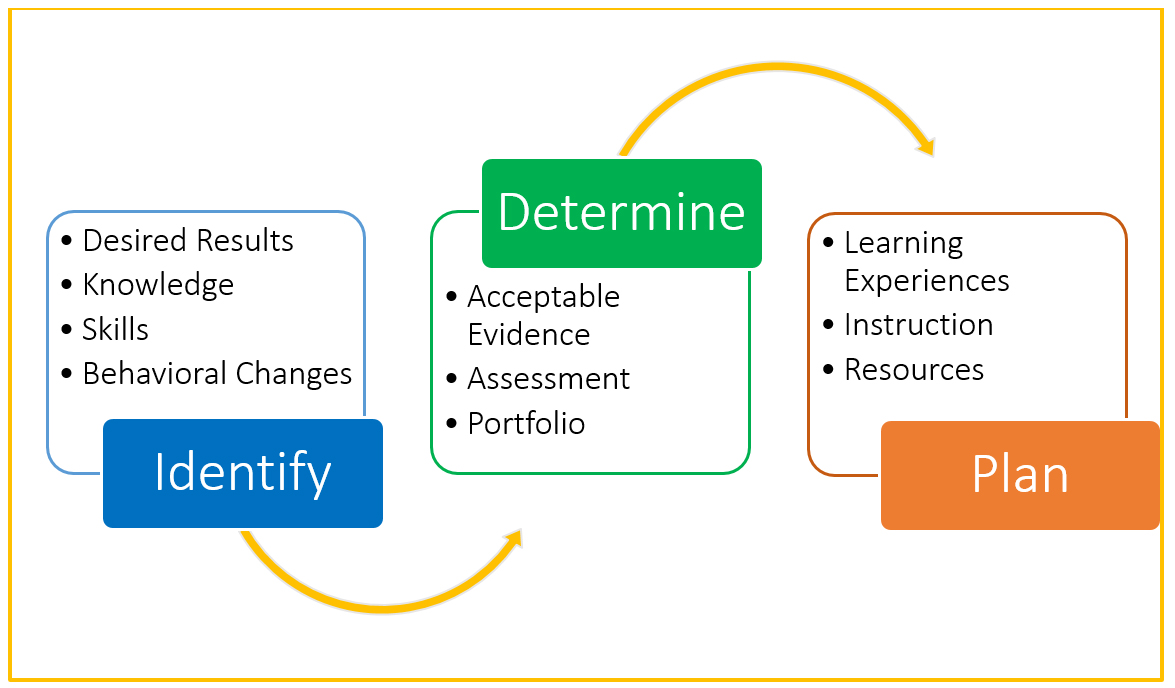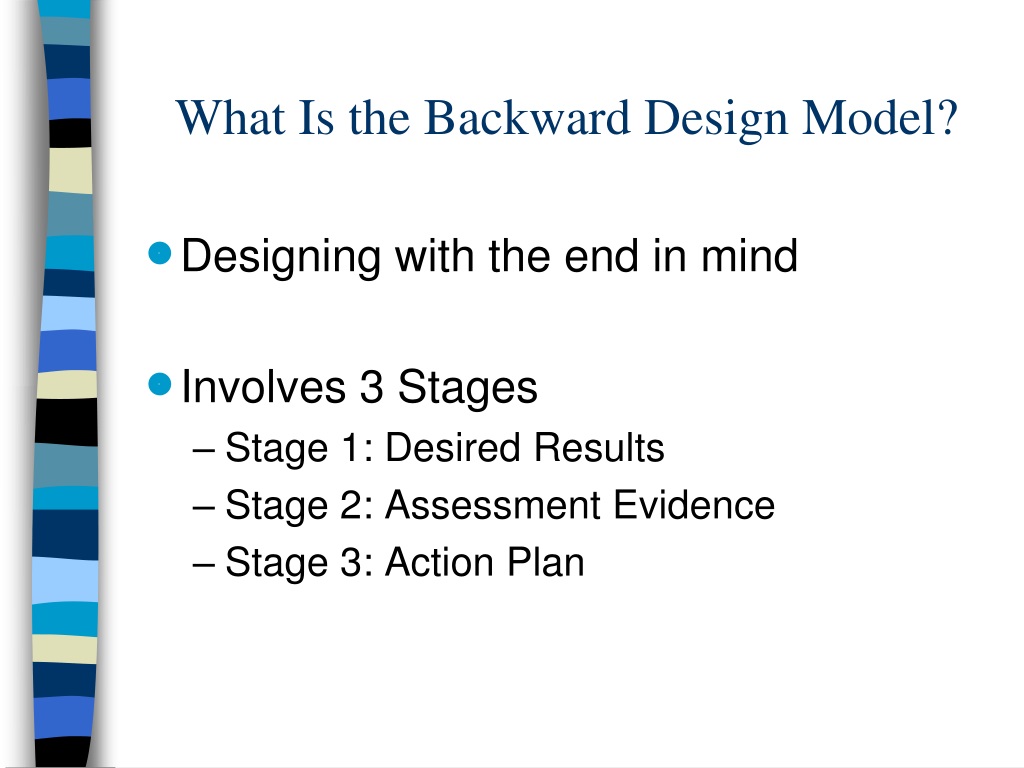Table Of Content

Contrary to a popular assumption, this does not mean that the leaning goal has to be quantitatively measured by some objective instrument (like a multiple-choice test). Valid and accepted measurements will vary from discipline to discipline and include both quantitative and qualitative measures. As the course designer, you decide what kind of measurements will work best for your subject. The important thing is that there is some way to identify whether or not learning outcomes are being met. The primary benefit of backward design is that it is focused primarily on student learning.
Related content
The first question listed above has instructors consider the knowledge that is worth being familiar with which is the largest circle, meaning it entails the most information. The second question above allows the instructor to focus on more important knowledge, the knowledge and skills that are important to know and do. Finally, with the third question, instructors begin to detail the enduring understandings, overarching learning goals, and big ideas that students should retain. By answering the three questions presented at this stage, instructors will be able to determine the best content for the course.
I. Identify the desired outcomes
Similarly, a cut, paste, and coloring activity that might be engaging, but is more of an arts and crafts activity with a little bit of math thrown in, is also not appropriate. Every effort should be made to focus the student's time during this segment on mastering the objectives, using real world applications if possible. The first step to producing quality online, blended or face-t0-face courses is quality course design.
Step 1: Identify the Desired Results
The “full” version of Wiggins and McTighe’s original approach is pretty complex and can be time-consuming to implement. For now, though, I’m just going to share the most basic version of backward design. Notice that in this approach, the assessment is created after the lessons are planned. Sometimes it isn’t created until most of those lessons have already taken place. The assessment is kind of an afterthought, a check to see if students were paying attention to the stuff we taught them.
Basic Steps of Backward Design Lesson Plans
Think explicitly about how to organize your content logically given your course subject matter. Possibilities include sequencing it chronologically, around key themes, from simple to complex disciplinary skills, from theory to application, and so on. This is the material you present alongside your main course content to support students with the necessary disciplinary knowledge or foundational skills that underpin or relate to it. Backward design, or the backloading of curriculum, is often used when the traditional frontloading of curriculum is not practical. Frontloading becomes impractical when state or local districts adopt assessments that do not reveal the content of what is tested.

Wiggins and McTighe propose a framework called Six Facets of Understanding as a guide for building effective assessments. It is made up of six non-hierarchical ‘domains’ or ‘facets’ that they identify as indicators of understanding. In the first stage of backward design, instructors identify what students should know, understand, and be able to do by the end of the course, lesson or module. What students are likely really saying is that they don’t understand how the test reflected the content they thought they studied or learned. Or perhaps they don’t feel they were able to adequately demonstrate what they did learn based on the types of questions they were asked on the exam. In other words, they don’t see an alignment between what they learned and what they were tested on.
1988 Jaguar XJS - Vellum Venom - TheTruthAboutCars
1988 Jaguar XJS - Vellum Venom.
Posted: Wed, 20 Jan 2016 08:00:00 GMT [source]
I had decent relationships with my students and I believe most of them had good experiences in my classroom, but real, durable learning? The big ideas and important understandings are referred to as enduring understandings because these are the ideas that instructors want students to remember sometime after they’ve completed the course. This teaching guide will explain the benefits of incorporating backward design. Then it will elaborate on the three stages that backward design encompasses. Finally, an overview of a backward design template is provided with links to blank template pages for convenience. In no time at all, you might see improvements in the performance of your students, the quality of your classes, and the ratings of your online lessons.
Basically, focus on identifying the desired results, which should be student-centered. Then your course design will have learning experiences tailored toward those learning outcomes. There are merits to both traditional lesson planning and backward lesson design, but key differences can create challenges for some teachers and students.
Aligning assessments & instruction
Reducing excessive and/or extraneous cognitive load is completely in the hands of the instructor. How will students be able to know they have succeeded in learning the core concepts and competencies? Consider various forms of both formative and summative assessment (see more in the assessment tab below). If you're an Ohio State educator looking for more support with course design, there are a number of resources at your disposal. In addition to browsing our growing repository of teaching topics, we encourage you to explore the following professional development activities. Backward designing an online course leads you to be more intentional about your use of the online space, helping to mitigate the challenges of online learning while maximizing its affordances.
Exercises designed to allow students to practice using new knowledge, or gain new skills, will give them a sense of mastery over the content that mere memorization cannot. Posing hypothetical questions or problems designed to allow students to apply new knowledge, or to practice newly acquired skills, will give them a sense of mastery that mere memorization cannot. In addition to these guidelines, it is also helpful to categorize the goals you have for the course in order of importance. The reason for this is because within the limits of the course, such as time, it is likely that you will need to prioritize certain goals over others to ensure that the most important learning outcomes are achieved.
Ensure that various, appropriate levels of challenge are represented in your outcomes so you can measure how close students are to achieving the learning goal. You’ll probably have somewhere in the range of three to seven learning goals for the course you are designing. Using a process like backward design helps us get better at making these decisions. By making this approach part of our regular practice, we’ll be able to look back on a day, a week, or a year of teaching and say with a lot more certainty that when they were under our care, our students learned. I was first introduced to this concept in my sixth year of teaching, and the genius of it completely blew me away. I used it when planning my next unit and experienced the biggest spike in student success I’d ever seen.
With intended learning outcomes in hand, the next step of the backward design process is to create assessments that appropriately measure students’ attainment of intended learning outcomes. Various kinds of assessments can fill this role, as long as the assessment task is closely aligned with the action described in the ILO. Since the point of defining ILOs is to provide a design focus for your course and to clarify goals for students, specificity is very important. In your statement of your learning outcomes, it should be clear exactly what the goal is. In particular, beware of words like “understand” or “know.” Exactly what it means to “understand” or “know” something is open to interpretation. An undergraduate’s level of “understanding” of a topic and that of the instructor will vary wildly, and it will be difficult for students to know which level of understanding they should be aiming for.
To help you define the curricular priorities for the course, Wiggins and McTighe suggest the following three questions to help you progressively narrow in on and define the most important content areas. As you create assessments and instructional strategies, keep student understanding at the forefront. Educators like Grant Wiggins emphasize that the ultimate goal of Backward Design is not just to teach content but to facilitate true understanding and application of knowledge. One of the most celebrated aspects of Backward Design is its focus on clear learning objectives. By defining what students should know or be able to do by the end of a lesson, educators can offer a more targeted and effective learning experience.
Predictably, some fell behind in the book like they did with all assigned reading. In the following video, Dr. Stephanie Chasteen and others from the University of Colorado Boulder introduce the concept of backward design with some specific examples of how it can be used in developing curriculum for STEM courses. Wiggins and McTighe argue that backward design has a host of benefits that make both the process of creating curricula and the process of teaching curricula intentional and intuitive. The key question is whether a one-size-fits-all approach can adequately cater to a classroom that is increasingly diverse in terms of learning styles, physical abilities, and cultural backgrounds. According to these critics, the structured, step-by-step nature of Backward Design could potentially stifle spontaneity and limit opportunities for exploratory learning.
On top of that, I was actually excited about teaching the lessons I had planned. For the first time, it felt like none of my class was wasted; everything actually mattered. In their book Understanding by Design, which was originally published in 1998, Grant Wiggins and Jay McTighe introduced us to backward design, an approach to instructional planning that starts with the end goal, then works backward from there.
The illustration below shows an alignment between specific assessment types and the different types of evidence they provide. Both the Dick and Carey model and the backward design model are goal and objective oriented; assessment is created based on learning objectives and goals, and instruction is created based on evaluation and assessment. The Dick and Carey model, however, is a more systemic model in that making changes to components affects other components and, therefore, the changes occur in parallel. In the more linear backward design model, the steps are non-flexible which means that skipping or changing steps is not an option.







